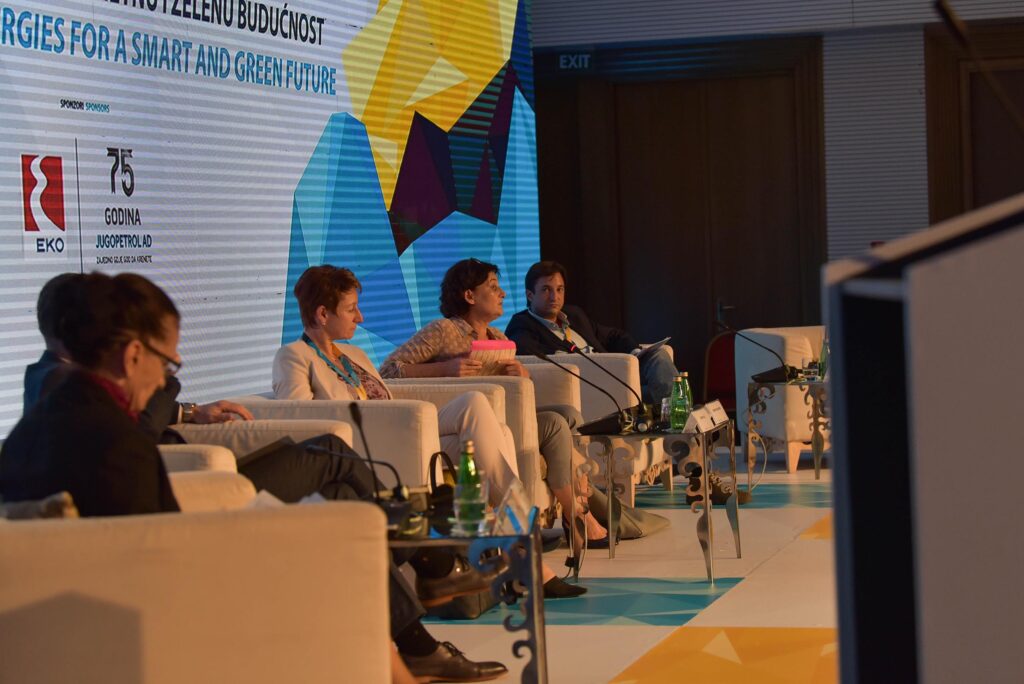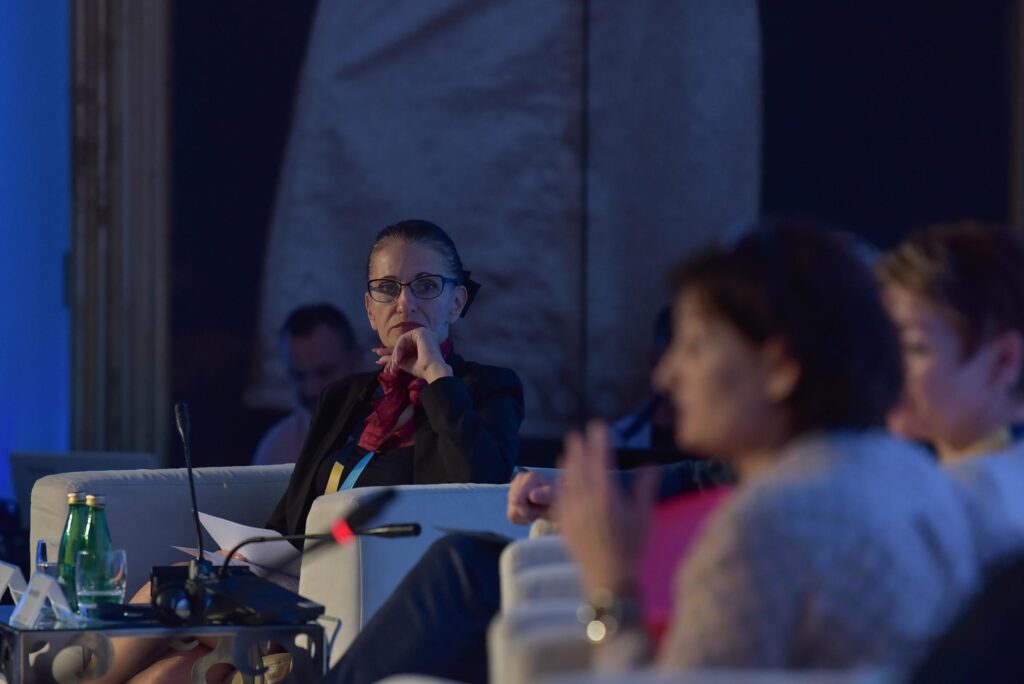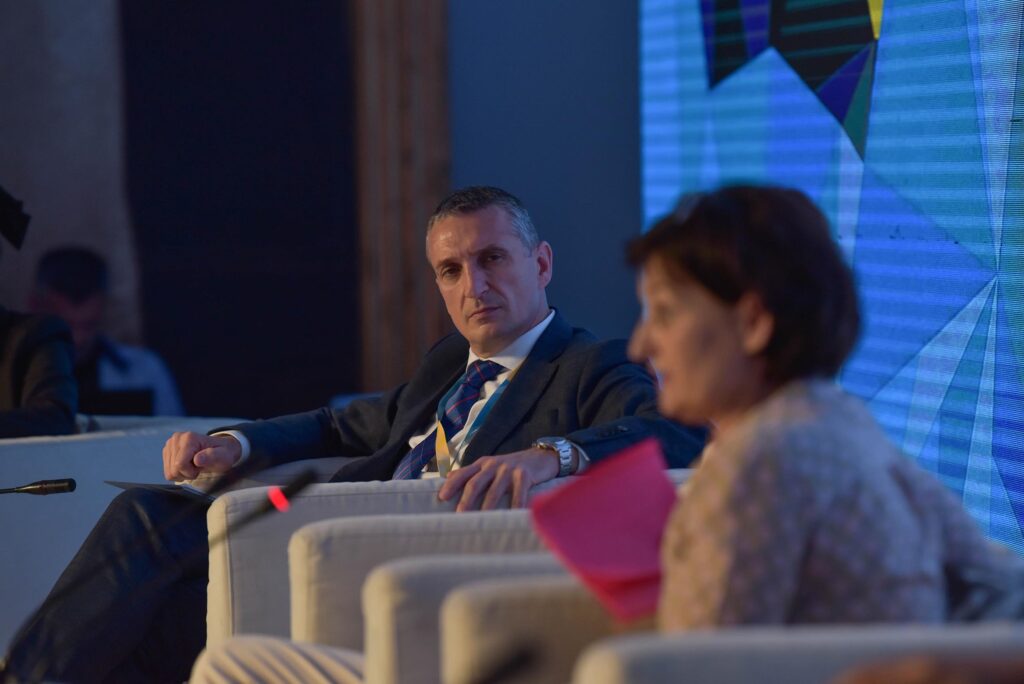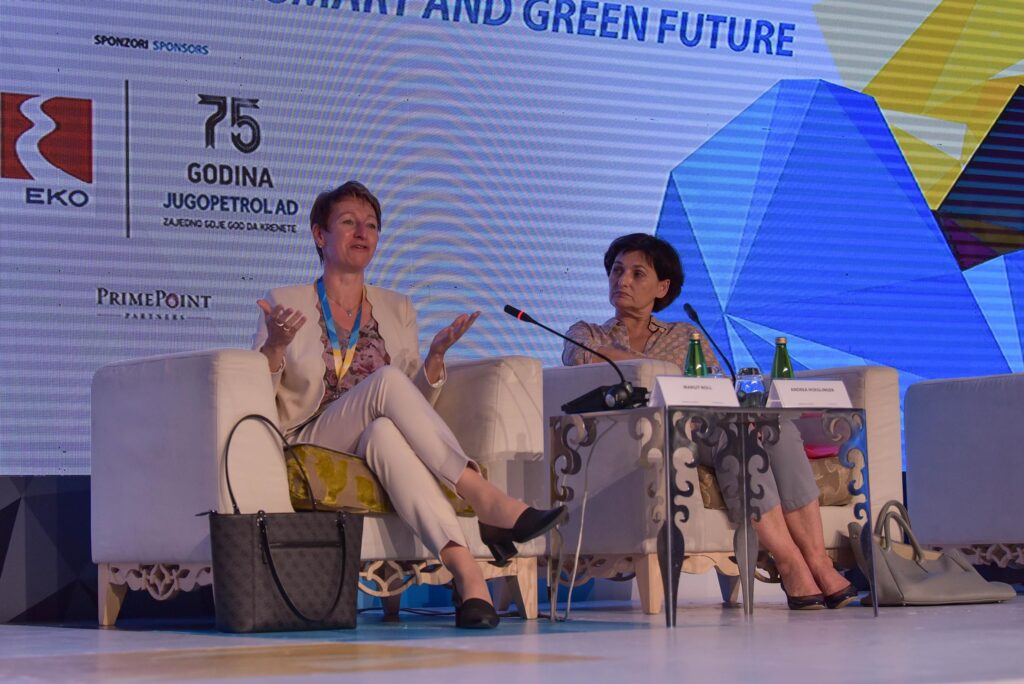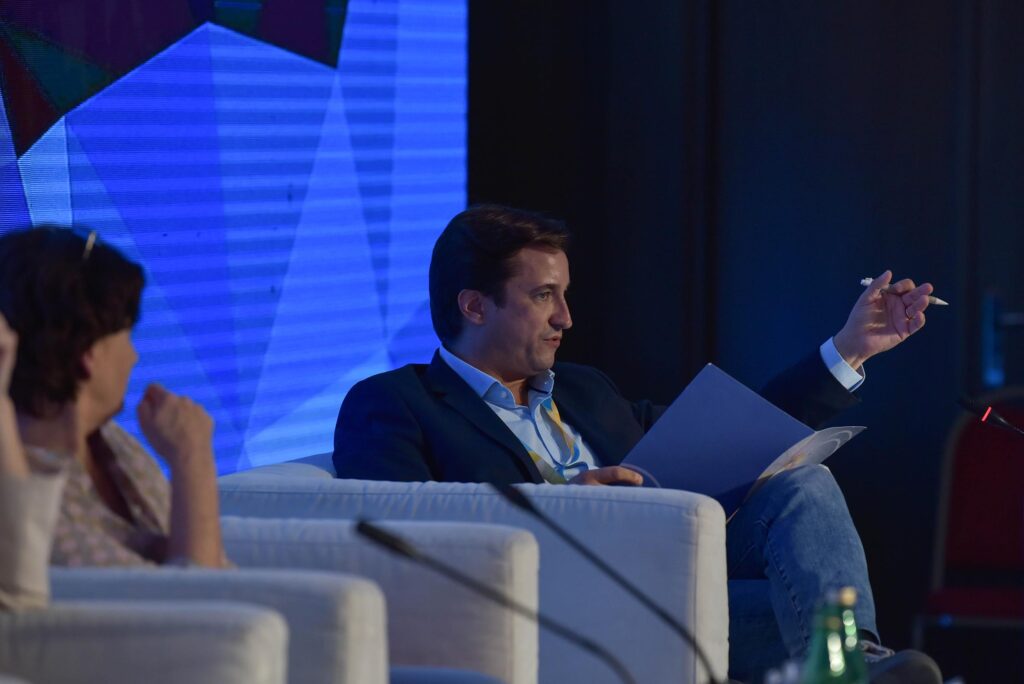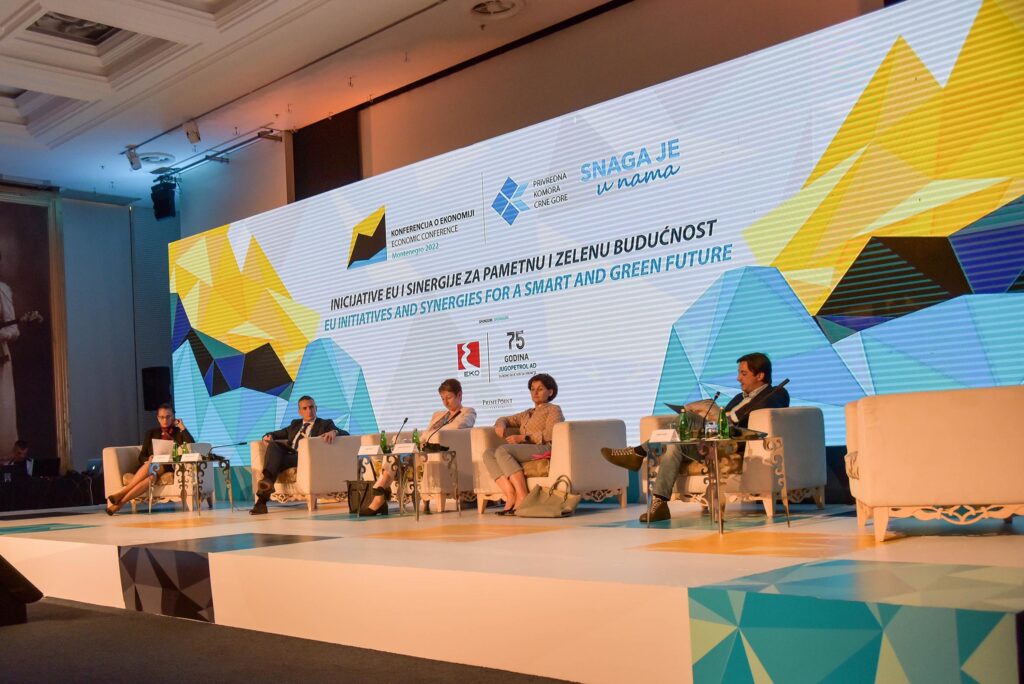The Green Agenda for the Western Balkans is seen as a new growth strategy for the region, leaping from traditional to sustainable economy. The panelists debated the main reasons behind the challenges of implementing the Green Agenda, and the ways to move forward by connecting the lagging WB system to the broader EU initiatives and opportunities for a successful green transition. Among other topics, a particular emphasis was put on Circular Economy and the Smart City concept. The panel was also an opportunity to give visibility to success stories in the WBs.
Five speakers were anticipated at the panel, three of them were proposed by the POLICY ANSWERS to promote European Partnerships, Missions and EIT opportunities for the Western Balkans. The panelists were 1) Ladeja Godina Košir, Founder and Executive Director of Circular Change in Slovenia and Co-Chair of the European Circular Economy Stakeholder Platform (ECESP) in Brussels, 2) Radovan Nikčević, Project Manager and Senior expert on the Green Agenda, UNDP Serbia, 3) Margit Noll, CEO, Driving Urban Transition Partnership, European Partnerships, 4) Andrea Hoeglinger, Head of European and International Programmes, Austrian Research Promotion Agency, and 5) Ignacio Chanza Bango, Strategic Developer for Southern Europe, EIT Climate KIC. The session was moderated by Professor Srna Sudar, University of Montenegro.
Ladeja Godina Košir focused on the topic of circular transition as a key sustainability strategy related to green economic growth and development. She emphasized the importance of the road-mapping process for organizations, cities, region or governments to start the circular economy journey. However, to get changes happening, she emphasized the importance of the systematic approach, underlining the need to align the legislation in the WBs with the EU legislation and to promote new incentives developed by the EU to empower the circular economy transformation. This was an opportunity to give visibility to her co-authored and the recently published ‘Roadmap Towards the Circular Economy in Montenegro’, which was developed by the Chamber of Commerce of Montenegro in cooperation with the UNDP.
In the Western Balkans, UNDP plays a big role in the implementation of the Green Agenda for the Western Balkans. As an example, the EU as well as countries like Switzerland and Sweden contribute to an initiative in Serbia designed to enable, facilitate and accelerate the processes of Green Transition. Overall about 16 mio euro will be used to support the Green Agenda for WB based on the same five pillars, through the project ‘EU for Green Agenda in Serbia’. The project was presented during the Panel session by Radovan Nikčević, who is responsible for its management on behalf of UNDP Serbia. The interventions include support to the government of Serbia in developing strategic and institutional frameworks to run green transitions, direct support to projects which contribute to climate change mitigation, circular economy, decarbonization, reduction of air-, water- and soil pollution, sustainable food system and rural development through a specific instrument called “Challenge Calls”. Interested parties are invited to submit project ideas who will receive support to become implemented and scaled up. Some projects with high environmental, social and economic benefits will also receive direct co-financing. This is a great example of the success story in Serbia, which according to Nikčević could be transferred to the entire WB region since there is a visible interest for that.
In the course of the panel, Andrea Hoeglinger introduced the five EU Missions as new means of addressing major societal challenges and their benefits for the successful implementation of actions and policies in reaching the Green Agenda sustainable development. She also emphasized that one of the five missions is ‘Climate-neutral and Smart Cities’ which is of great interest for Montenegro, given that Podgorica was chosen to be one of the 100 European cities to be supported in achieving this mission by 2030. Although the Missions are part of the largest funding European Programme for Research and Innovation, Horizon Europe, worth more than 90 billion EUR, Hoeglinger emphasized that the Missions are not only research and innovation related. Missions have clearly formulated goals, they are usually broad and they are of transformative nature. This means that the goal of Missions cannot only be achieved by research and innovation, but requires social research, change of our behavior and involvement of different policy areas.
A completely new and complex model of working is needed, involving different ministries, different regulations, excellent expertise on how to involve citizens because more awareness is needed as well as readiness for new education programmes. She pointed out that it is clear that the new governance models are needed if we really want to use the transformative strength of Missions. This is why the European Commission called the Member States and the Associated countries to start the national governance processes as an implementation process.
In this direction, the Austrian Research Promotion Agency launched the project TRAMI (TRansnational cooperation on the Mission approach) which focusses on making Missions work by creating communities of practice, exchanging knowledge and offering mutual learning with the aim of supporting all countries at the European level interested in European Missions. Andrea Hoeglinger pointed that TRAMI can also be the WBs facility and she invited the WBs to join this project. She also invited different stakeholders from the WBs to join the European Mission Network, aiming at becoming a recognized community of practice that supports and encourages mission governance, actors and stakeholders to successfully deliver the EU Missions’ objectives. Hoeglinger announced a special European Mission Forum which will be held on 25th January 2023 as an online event to bring the different actors.
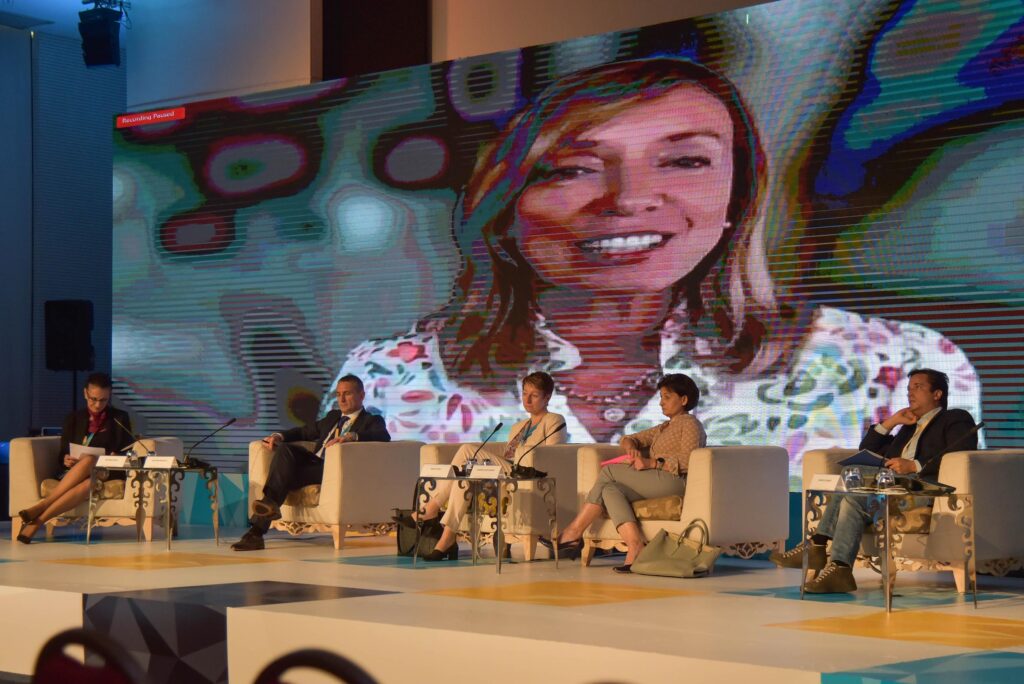
Margit Noll introduced the European Partnerships as a new framework focused on generating stronger policy impacts to contribute to the EU’s policy objectives of a green, digital and resilient Europe, including the EU Missions perspectives that clearly tackle the essential challenges we are facing.
She noted that the European Partnerships present a much more strategic and high-level policy approach which allows Member States to negotiate and prepare long-term research and innovation programmes co-funded by national authorities and the European Commission, which affect different policy levels. In the context of the green transition, two Partnerships were highlighted by her, the Driving Urban Transition Partnership and the Clean Energy Transition Partnership, both coordinated by Austria.
The Driving Urban Transition Partnership steps up the game to tackle urban challenges and complements the City’s Mission to support cities and create evidence, build capacity in cities to drive this transformation. The Clean Energy Transition Partnership focusses on the energy context and aims to empower the clean energy transition by developing the various technologies and system solutions needed for the transition (e.g. heating and cooling systems up to power technologies, integration in the environment). Both partnerships involve 28 or 32 countries from Europe, those which are joining forces and co-investing in European Partnerships to drive research and innovation in the policy relevant outcomes.
Exploring further the context of the Driving Urban Transition Partnership, Margit Noll emphasized that many calls have been launched focusing on what cities need. She noted that this is not a research program driven by researchers, but it is driven by the needs of cities to ensure that the research being funded has a local impact in our cities. She then noted that this new framework for research and innovation investment, which is able to bring all the actors together, is really essential. Noll pointed out that it is not only about the traditional research projects, it is about co-creation, cooperation of all actors from business, civil society, local initiatives, city administrators, infrastructure providers, they just team up with researchers to address the issues that are important for the cities in the first place.
Cities pull in their money based on their national priorities and their national strategies and programs, but behind that is a comprehensive program management, which works for the project and tries to turn that into a policy-relevant output, to create guidelines and references in case the other cities and the other actors would like to build on it. These Partnerships create a framework for countries to engage, join and co-invest. The panelist invited the WBs to investigate under what circumstances cooperation could be possible, and pointed out that both Partnerships she mentioned are very open for new partners and members.
To this end, Ignacio Chanza Bango introduced the European Institute for Innovation and Technology (EIT) as a catalyzing system-innovation established by the European Commission with a mission to create impact and develop the world-class solutions to the climate and other societal challenges we are facing. He noted that EIT has created Knowledge Innovation Communities (KICs), which are innovation knowledge triangles that bring together leading businesses, education and research organizations, but also public authorities to form large dynamic cross-border partnerships. Each KIC is dedicated to find solutions to a specific global challenge. EU initiatives such as the EIT and its Knowledge Innovation Communities KICs are also becoming increasingly active in the WB region. The fact that there are three cities in the WB who are already selected to be part of the “Climate Mission” is also encouraging and some countries have expressed interest to join EU Partnerships.
In the context of green transition, Ignacio Chanza Bango highlighted the EIT Climate KIC, which is a Knowledge Innovation Community that aims at creating a prosperous, inclusive and climate-resilient society with circular net-zero emission economy. He acknowledged the broadness of climate change, which is why this KIC focused on system innovation for climate change in areas with the highest emissions. That is why they are working on cities, and that includes energy and circular economy approach. As already pointed out before by Margit Noll, Ignazio Chanza Bango confirmed from the EIT perspective that an innovation is essential for the transition, but a completely new model of interconnected innovation is needed to catalyze the systematic change. He recorded that for 10 years (since the establishment of EIT in 2008) the institution supported many start-ups, single innovation projects, but they also realized the limited scale and the speed to decarbonize the planet. In order to catalyze the systematic change and to respond to the climate emergency more effectively, the EIT Climate KIC focused the efforts on a systematic innovation approach, bringing the full force of the innovative community to tackle multiple levels of change, to generate options and pathways for radical transformations in whole countries, cities, regions, industries and value chains. The panelist pointed out that the EIT Climate KIC adopted a new Deep Demonstration methodology. Deep Demonstrations are large-scale projects implemented across different positions in systems where all the key stakeholders are included – society, citizens, majors, large companies, banks, public administration – while the system innovation is offered as a service. The world needs inspiration and proof that inclusive, fast and large-scale change is possible to achieve net zero emission in time. He remarked that the EIT Climate KIC is a community of 450 Partners, the total funding is 4 billion EUR, they supported 1800 start-ups, created 10 000 jobs and launched on the market 600 innovation products and services. They are supporting 30 cities and they are involved in 40 European countries.
In conclusion of the panel discussion, all panelists agreed that the main economic sectors to be focused-on in the WBs for the successful implementation of the Green Agenda and the Circular transition are first of all the energy sector which requires a serious transformation in the future, the transport sector which together with the energy sector contributes about 80% in terms of greenhouse gas emission, and waste management in the third place with the potential to reduce pollution, but also to ensure energy production. It was acknowledged that the energy transition, the mobility transition and the circularity in terms of resources are highly interconnected. The panelists strongly emphasized the huge potential of the public sector (e.g. energy savings), which was ranked on the fourth place. The issue of innovation in the public sector was highlighted in the sense that to get this transition going, not only new business, ideas and innovation are needed, but the public sector and the city administration have to be able to deal with new technologies and solutions, to understand and anticipate their potential, or even to put them in the context of their own development. The modernization of the management and moderation scheme on how cities are developed and how to run them is an essential transformation process on the side of the public authorities and governance level to gradually bring a sustainable future.
The last point addressed the importance of human capacities, new knowledge, expertise and skills for green transformation. All the panelists agreed that the transition would not happen if people would not have the awareness, knowledge and skills to drive the transitions forwards.
The situation in the Western Balkans is particularly challenging, given the fact that the brain drain is a major problem in this region. It was pointed out that the new knowledge cannot be created with the old mindset. One of the challenges is connected to the education system, which is too slow to integrate new subjects, new topics, new knowledge, so it takes too much time to create a new curriculum. It was noted that a transformative process is needed, big changes in education, training and lifelong learning, but also research have to advance in cross-disciplinarity. It was also emphasized out that for the green transition and the circular economy, not only highly skilled people are needed, but also handy people, and both are equally needed.
Another challenge for the WBs is how to give value to these handy people and how to mobilize the knowledge that is there. In conclusion all panelists agreed that capacity building, such as the education programmes and courses offered by the EIT KICs, are essential.
_________
To find out more about the event, please visit the Pages linked below.
